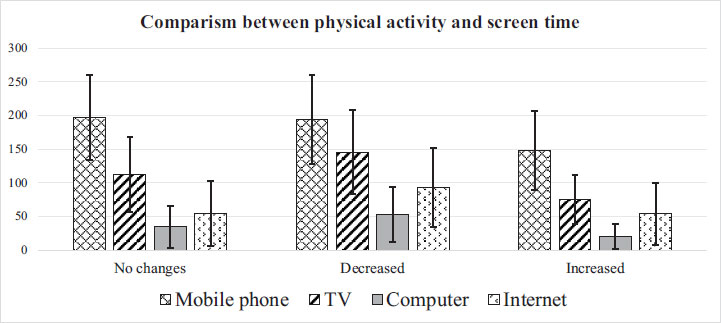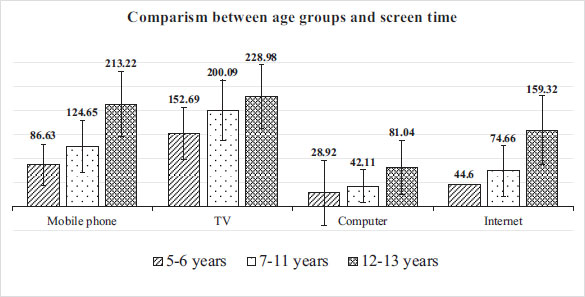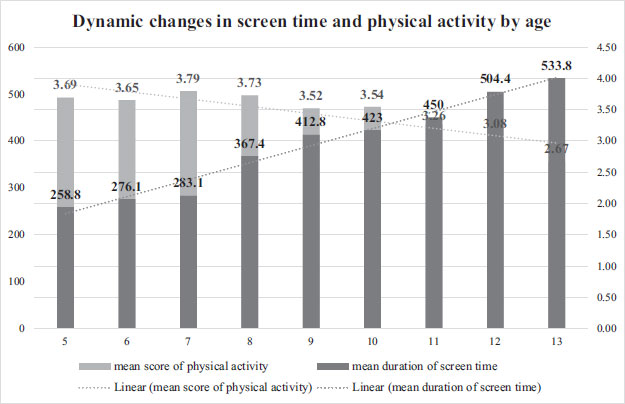All published articles of this journal are available on ScienceDirect.
Physical Activity and Screen Time of Children Aged 5-13 Years during the COVID-19 Lockdown in Mongolia: A Cross-sectional Study
Abstract
Background:
A novel coronavirus infection (COVID-19) has posed a significant threat to global health and the economy over the last two years. In December 2019, a novel coronavirus infection began in Wuhan, China, and quickly spread throughout the world. Since January 2020, the Mongolian government has enforced a social distancing policy, and the country has been one of the few where the disease has not spread. In the 143 days since the outbreak, 575 cases have been reported, resulting in three cases of public emergency preparedness and 50 days of lockdown. The new school year began in September 2021, but due to the Covid-19 pandemic, children will be required to study online from home again on 12th November. It was interesting how the pandemic lockdown affected screen time and physical activity in children.
Objective:
We aimed to assess the relationship between physical activity (PA) and screen time (ST) of children aged 5-13 years’ Mongolian residents during the COVID-19 lockdown.
Methods:
The observational cross-sectional study was conducted during the COVID-19 lockdown between 5th Feb and 9th March 2021 which was the second lockdown of Mongolia, and we have studied 1005 children aged 5-13 years from the capital city. The questionnaire was used which was prepared by the study team and the questionnaire included 33 questions to evaluate screen time and physical activity. All parents reported the questionnaire to give some information about their children. We used appropriate statistical methods in SPSS software.
Results:
A total of 1005 children aged 5-13 years from 628 families were involved in the survey which included 51.9% boys and 44.1% girls. The median of PA and ST was 300 minutes [min, max: 0, 1260] and 30 minutes [min, max: 0,180]. The linear regression revealed a weak negative correlation (r2=0.005, p<0.0001) between PA and ST. When ST and PA analyzed in age by age groups, there was a statistically significant negative dynamic of ST mean time and PA mean score (p<0.0001). Older kids have more ST and lower PA during lockdown time. During this lockdown, 60.4% of the parents reported that their children showed a decrease in PA.
Conclusion:
The mean score of physical inactivity has decreased and ST increased dramatically among children 5-13 years as a result of the Covid-19 lockdown.
1. INTRODUCTION
A novel coronavirus infection (COVID-19) has posed a significant threat to global health and the economy over the last few years. In December 2019, a novel coronavirus infection began in Wuhan, China, and quickly spread throughout the world [1-3]. In the event of a pandemic caused by this infection that has not been effectively treated, quarantine and distance measures were the best way to control the source [4]. Almost every government, including China, Germany, the United States, and France, has declared a state of emergency and imposed curfews as a result of this. Schools and kindergartens were closed, as were unnecessary public and private services, and employees were relocated from their workplaces to homes [5, 6].
Since January 2020, the Mongolian government has enforced social distancing policy, and the country has been one of the few where the disease has not spread [7]. In the 143 days since the outbreak, 575 cases have been reported, resulting in three cases of public emergency preparedness and 50 days of lockdown [8]. Furthermore, according to a Mongolian government decision, children are required to participate in e-learning from January 2020 to November 2021. Besides that, children are no longer permitted in public places. The new school year began in September 2021, but due to the Covid-19 pandemic, children will be required to study online from home again on 12th November [9].
To maintain a healthy lifestyle, the WHO and the United States Guidelines for physical activity (PA) recommend that children exercise for an average of 60 minutes per day and limit screen time (ST). The advancement of technology and digital communication is influencing people's working, learning, travel, and lifestyles [10, 11] PA is essential in the prevention of non-communicable diseases, particularly obesity, cardiovascular disease, and cancer [12]. According to recent studies, the length of time children and adolescents spend on screens is increasing as a result of the COVID-19 lockdown [13, 14].
In this study, we aimed to assess the relationship of PA and ST of children 5-13 years during the COVID-19 lockdown.
2. MATERIALS AND METHODS
Our quantitative study was carried out using an observational, cross-sectional study in which a single measurement was made for a single group. An online survey of 1005 children 5-13 years’ Mongolian residents during the COVID-19 lockdown between 5th February and 9th March 2021. Data collection was performed online using the Google Form platform. The call for participation was made on social media. The selection of the participants was done by convenience; families with children 5-13 years during the COVID-19 pandemic were invited to participate. All respondents were parents and accepted informed consent. The questionnaire was used which was prepared by team members and included 33 questions about sociodemographic variables, each child's daily exercise at home, ST, and sleep patterns. Participants' PA as compared to their age, gender, indoor playground, and ST.
PAs for children include education, community or household recreation (games, competitions, sports, exercises), physical education classes, transportation (walking, cycling, etc.), and house chores. Sedentary work, relaxation, and ST all contribute to a sedentary lifestyle (TV, computer, phone, tablet, etc.). “Screen time” is defined as time spent in front of a screen, such as watching TV, working on a computer, or playing a video game. Staring at a screen is either passive or has low energy consumption.
2.1. Assessment of PA Scoring
Seven PA questions were graded with a no - 0 or yes - 1 response.
- 2< points – insufficient
- 3-5 points – moderate
- 6-7 points – sufficient
The study was conducted in accordance with the Declaration of Helsinki and approved by the Ethics Committee of the Institute of medical sciences, Mongolian National University of Medical Sciences (No. 2021/D-03). A descriptive analysis was used to determine the sociodemographic characteristics and behaviors during the COVID-19 pandemic using the mean deviation (M), standard deviation (SD), and frequencies (%). To establish the differences between the variables, we used the student’s t-test for independent samples and the one-factor ANOVA, employing Pearson’s chi-square statistical indicator to verify such differences. Pearson’s bivariate correlations were thus used to establish the relationship between more than two groups, and the correlation between PA and ST respectively. All statistical analyses were two-sided, with P-value less than 0.05 considered statistically significant. The statistical software SPSS 25.0 (IBM Corp, Armonk, NY, USA) was used for data analysis and processing.
3. RESULTS
A total of 1005 children aged 5-13 years from 628 families were involved in the survey. The mean age was 8.12 ± 2.56, all age by age groups with 51.9% male and 44.1% female. 163 respondents lived in private houses, 117 in yurts, and 779 in apartments, respectively (Table 1). During the COVID-19 lockdown, 658 (60.4%) of the children reported a decrease in PA (Table 2), with a 30 minutes median time spent exercising [min, max: 0.180]. Furthermore, 187 of the 5-6 age group, 318 of the 7-11 age group, and 76 of the 12-13 age group followed a TV or online exercise. Parents of 195, 315, and 95 children aged 5-6, 7-11, and 12-13 respectively, reported trouble finding suitable exercise for their children's bodies and age growth.
Active physical games were played by 279 of the 5-6 age group, 439 of the 7-11 age group, and 89 of the 12-13 age group. 282 (88.4%) of the 5-6 age group, 432 (81.5%) of the 7-11 age group, and 89 of the 12-13 age group were at home playing running games while 79 (53.4%) of the 12-13 age group were not. 168 of the study's 5-6 age group reported doing walking exercises, while 266 of children aged 7-11 and 56 of children aged 12-13 did not. 285 of the 5-6 age group, 478 of the 7-11 age group, and 131 of the 12-13 age group did not exercise with the equipment. 209 of the 5-6 age group, 320 of the 7-11 age group, and 93 of the 12-13 age group did not perform any other workout.
The study's children had a mean PA score of 3.5 ± 1.7, suggesting moderate PA. The PA scores decreased when age increased. As compared to time spent on mobile phones, tablets (p<0.001), TV (p<0.0001), video games (p<0.0001), the Internet, and social networks (p<0.0001), PA was statistically significant (Fig. 1). 934 (85.4%) participants attended the e-learning activity, but not 74 (6.8%). The median of ST was 300 minutes [min, max: 0, 1260] throughout the Covid-19 lockdown. The median time spent watching TV by children was 180 minutes [min, max: 0,420]. On a scale of watching TV minutes, 43 (3.9%), 279 (25.6%), 127 (11.7%), 213 (19.5%), 225 (20.6%), and 139 (12.8%) children spent up to 30, 60, 120, 180, 300, and 420 minutes, respectively. For the 5-6, 7-11, and 12-13 age groups, the average daily time spent watching mobile phones, tablets, TV, computer games, the online, and social networks was 5.2 ± 5.5, 7.4 ± 6.85, and 11.38 ± 8.78 hours, respectively.
Age groups were statistically significant when compared to time spent on mobile phones, tablets (p<0.001), TV (p<0.0001), video games (p<0.0001), the online and social networks (p<0.0001), listening to music (p<0.0001), and calling (p<0.011) (Fig. 2). The linear regression revealed a weak positive correlation (r2=0.005, p<0.0001) between PA and ST. The PA decreased when ST increased. 575 (52.8%) of the children had less than 12m2 of the indoor playground while 514 (47.2%) had more. There was no statistically significant difference between PA and the indoor playground (p<0.31). 633 (58.1%), 262 (24%), 44 (4%), and 5 (0.5%) of the children were cared for by 1 to 4 adults, respectively, while 137 (12.6%) had no caregiver. Children typically sleep at 10 p.m. before the lockdown, which was extended to midnight during the lockdown (Table 2).
| Variables | Numbers (%) |
|---|---|
| Age group | - |
| 5-6 years | 323 (29.6) |
| 7-11 years | 533 (48.9) |
| 12-13 years | 149 (13.7) |
| Gender | - |
| Boys | 566 (51.9) |
| Girls | 481 (44.1) |
| Housing type | - |
| Private house | 163 (15) |
| Mongolian traditional yurt | 117 (10.7) |
| Apartments | 779 (71.5) |
| Indoor playground size | |
| <12m2 | 575 (52.8) |
| >12m2 | 514 (47.2) |
| Adult caregivers in work time | |
| No one | 137 (12.6) |
| 1 person | 633 (58.1) |
| 2 person | 262 (24) |
| 3 person | 44 (4) |
| 4 person | 5 (0.5) |

| E-learning attendance | |
|---|---|
| Yes | 931 (85.4) |
| No | 74 (6.8) |
| TV watching duration | |
| No | 22 (2) |
| 30 minutes | 43 (3.9) |
| 60 minutes | 279 (25.6) |
| 120 minutes | 127 (11.7) |
| 180 minutes | 213 (19.5) |
| 300 minutes | 225 (20.6) |
| 420 minutes | 139 (12.8) |
| Changes in PA | |
| Decreased | 658 (60.4) |
| Increased | 194 (17.8) |
| No changes | 207 (19) |
| Bedtime | Median |
| Before lockdown | At 22 pm |
| During lockdown | At 24 pm |


4. DISCUSSION
Obesity, cardiovascular and metabolic disorders, stunted physical development, decreased participation in behavior and social interactions, and sleep disorders can all result from a lack of PA in children and adolescents. WHO guideline for PA recommends that children exercise for an average of 60 minutes per day and limit the duration of non-physically demanding behaviors, particularly screen-related behaviors. Sedentary behavior is defined as the length of time spent with less energy in school, at home, in public, or in a vehicle [9]. During the lockdown, 60% of the children in the study had a decrease in PA, which was in line with the findings of other studies [14-16]. Children aged 7-11 had the highest rate of exercise on TV and online, at 60.6%. Parents with children of all ages reported being unable to find age-appropriate PAs on TV or online, indicating a lack of access to e-learning classes in secondary schools. The number of children running and walking decreased as age groups increased during the lockdown. The fact is that, few children use different types of exercise equipment due to economic issues. Other types of exercise were also scarce among children. The mean PA score of all children in the study was 3.5 ± 1.7, or moderate, but the percentage of children with 6 and 7 points, or sufficient in PA (11.7% and 2.7%) was low. PA levels were lower in all age groups, but especially in children aged 12 - 13 (Fig. 3). Although 52.8% of the study's 1005 children exercised in an area of less than 12 m2, there was no statistically significant difference between the size of the exercise area and PA (p<0.31). According to the “Model Rules for Hygiene and Infection Control in Educational Institutions” of the Mongolian General Agency for Specialized Inspection, continuous writing activities for primary school pupils should not exceed 8-10 minutes, as writing lessons can easily tire children [17, 18]. However, due to increased online time and homestay during the Covid-19 pandemic lockdown, the median time spent watching online for children in the study was 180 minutes [min, max: 0.420]. This finding was 3-5 times longer than the duration of a single e-learning session (20 minutes), and 1-3 lessons per day are available online depending on the grade of the children [19]. Because the period specified in the rules above preceded the Covid-19 pandemic, changes in the current circumstances are considered necessary. Some countries around the world are launching programs that allow children to practice at home to prevent and reduce the effects of Covid-19 on PA [20]. For example, since the novel coronavirus infection, Canada has been implementing “PLAYBuilder” and “Appetite to Play” cloud-based programs for children's physical and mental health. These programs are intended to promote healthy eating and PA in young children. The “Appetite to Play” for families and caregivers includes self-assessment, planning, reading tips, recipes, games, and more [21, 22]. In the United Kingdom, the “SIMPLE Movement” aims to help every child develop reading, writing, sports, and play skills. This simple animated animation program aims to develop physical growth skills in a fun and enjoyable way [23]. There were statistically significant differences in time spent on mobile phones, tablets, TV, computer games, the internet, social media, listening to music, and phone calls among the three age groups, which was consistent with other studies' findings [13-15, 24]. The number of time participants spent staring at the screen increased as age increased (Fig. 2). The linear regression revealed a weak positive correlation (r2=0.005, p<0.0001) between PA and ST. Furthermore, 137 (12.6%) of the children surveyed, were at home without adult caregivers during the quarantine. There were no statistically significant comparisons of unaccompanied children with e-learning (p<0.85). However, the absence of adult caregivers at home during the quarantine period can lead to domestic accidents, injuries, malnutrition, and sleep deprivation. Moreover, children typically sleep at 10 p.m. prior to the lockdown, which was extended to 24 p.m. during the lockdown (Fig. 2). Children aged 5-13 were more inactive as a result of the lockdown, particularly when they spent more time staring at a screen, which affected children's bedtime. This could be attributed to an increase in the use and availability of modern technology, such as social networking and computer games, as well as an increase in time spent at home as a result of the lockdown and the introduction of online learning.
CONCLUSION
The mean score of physical inactivity has decreased and ST increased dramatically among children 5-13 years as a result of the Covid-19 lockdown. However, further studies need to investigate the ST and PA in children under the age of 16 and the survey needs to complete a questionnaire onsite in which the children’s ST and PA can be evaluated. Also, detailed parameters should be studied.
AUTHORS' CONTRIBUTIONS
Conceptualization, T.B and T.L; methodology, T.B, and G.D; software, B.D, and A.B; writing—original draft preparation, T.B, G.D; writing—review and editing T.L, B.B. All authors have read and agreed to the published version of the manuscript.”
LIST OF ABBREVIATIONS
| PA | = Physical Activity |
| ST | = Screen Time |
| IBM | = Index Body Mass |
ETHICS APPROVAL AND CONSENT TO PARTICIPATE
“The study was approved by the Ethics Committee of Institute of medical sciences, Mongolian national university of medical sciences (No. 2021/D-03).”
HUMAN AND ANIMAL RIGHTS
No animals were used in this research. All procedures performed in studies involving human participants were in accordance with the ethical standards of institutional and/or research committee and with the 1975 Declaration of Helsinki, as revised in 2013.
CONSENT FOR PUBLICATION
Informed consent was obtained from all participants.
STANDARDS OF REPORTING
STROBE guidelines were followed.
AVAILABILITY OF DATA AND MATERIALS
The data that support the findings of this study are available from the corresponding author, [T.B.] on special request.
FUNDING
None.
CONFLICT OF INTEREST
The authors declare no conflict of interest financial or otherwise.
ACKNOWLEDGMENTS
We thank our colleagues from the Department of Internal Medicine of the Institute of Medical Sciences, Mongolian National University of Medical Sciences who provided insight and expertise that greatly assisted us for the research.


